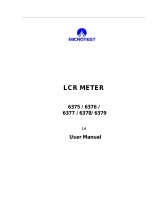
Operators of this product must be protected from electric shock at all times. The responsible body must
ensure that operators are prevented access and/or insulated from every connection point. In some cases,
connections must be exposed to potential human contact. Product operators in these circumstances must
be trained to protect themselves from the risk of electric shock. If the circuit is capable of operating at or
above 1000 V, no conductive part of the circuit may be exposed.
Do not connect switching cards directly to unlimited power circuits. They are intended to be used with
impedance-limited sources. NEVER connect switching cards directly to AC mains. When connecting
sources to switching cards, install protective devices to limit fault current and voltage to the card.
Before operating an instrument, ensure that the line cord is connected to a properly-grounded power
receptacle. Inspect the connecting cables, test leads, and jumpers for possible wear, cracks, or breaks
before each use.
When installing equipment where access to the main power cord is restricted, such as rack mounting, a
separate main input power disconnect device must be provided in close proximity to the equipment and
within easy reach of the operator.
For maximum safety, do not touch the product, test cables, or any other instruments while power is applied
to the circuit under test. ALWAYS remove power from the entire test system and discharge any capacitors
before: connecting or disconnecting cables or jumpers, installing or removing switching cards, or making
internal changes, such as installing or removing jumpers.
Do not touch any object that could provide a current path to the common side of the circuit under test or
power line (earth) ground. Always make measurements with dry hands while standing on a dry, insulated
surface capable of withstanding the voltage being measured.
For safety, instruments and accessories must be used in accordance with the operating instructions. If the
instruments or accessories are used in a manner not specified in the operating instructions, the protection
provided by the equipment may be impaired.
Do not exceed the maximum signal levels of the instruments and accessories. Maximum signal levels are
defined in the specifications and operating information and shown on the instrument panels, test fixture
panels, and switching cards.
When fuses are used in a product, replace with the same type and rating for continued protection against
fire hazard.
Chassis connections must only be used as shield connections for measuring circuits, NOT as protective
earth (safety ground) connections.
If you are using a test fixture, keep the lid closed while power is applied to the device under test. Safe
operation requires the use of a lid interlock.
If a screw is present, connect it to protective earth (safety ground) using the wire recommended in the
user documentation.
The symbol on an instrument means caution, risk of hazard. The user must refer to the operating
instructions located in the user documentation in all cases where the symbol is marked on the instrument.




















